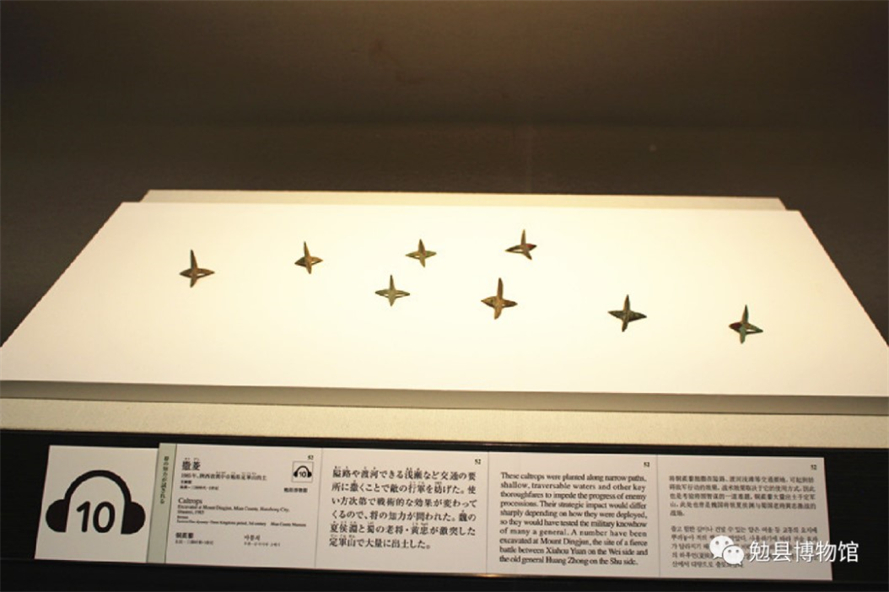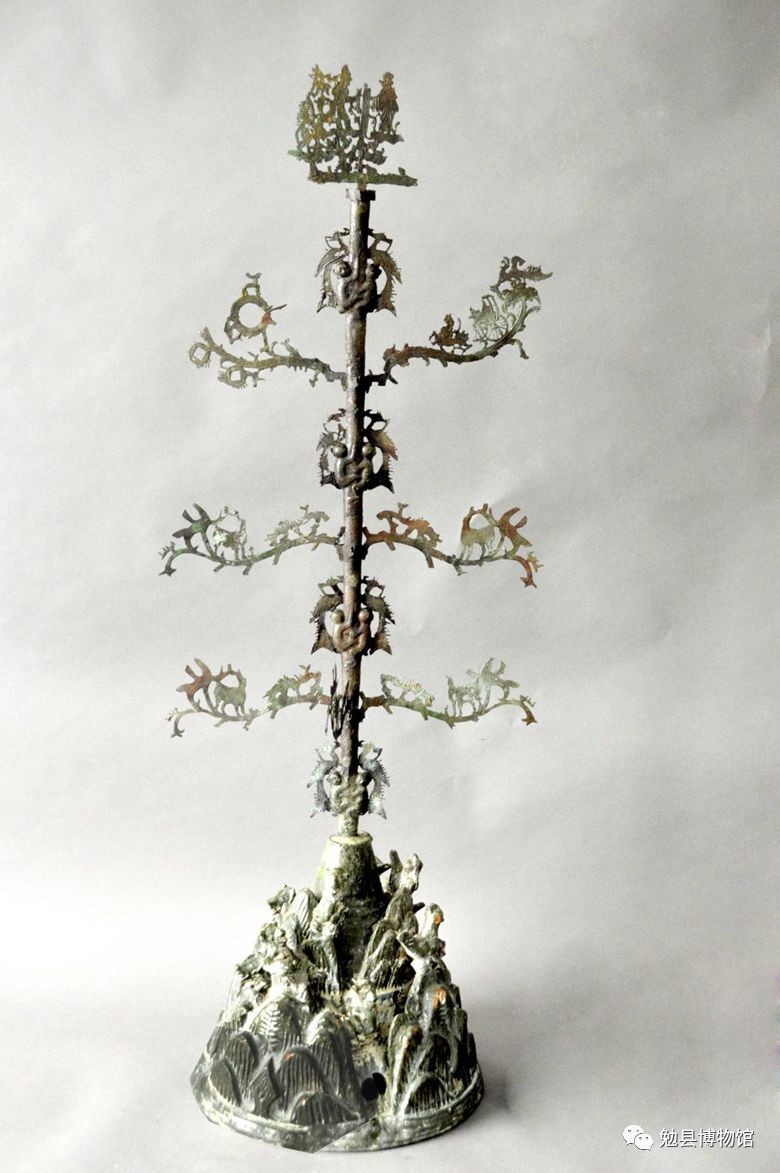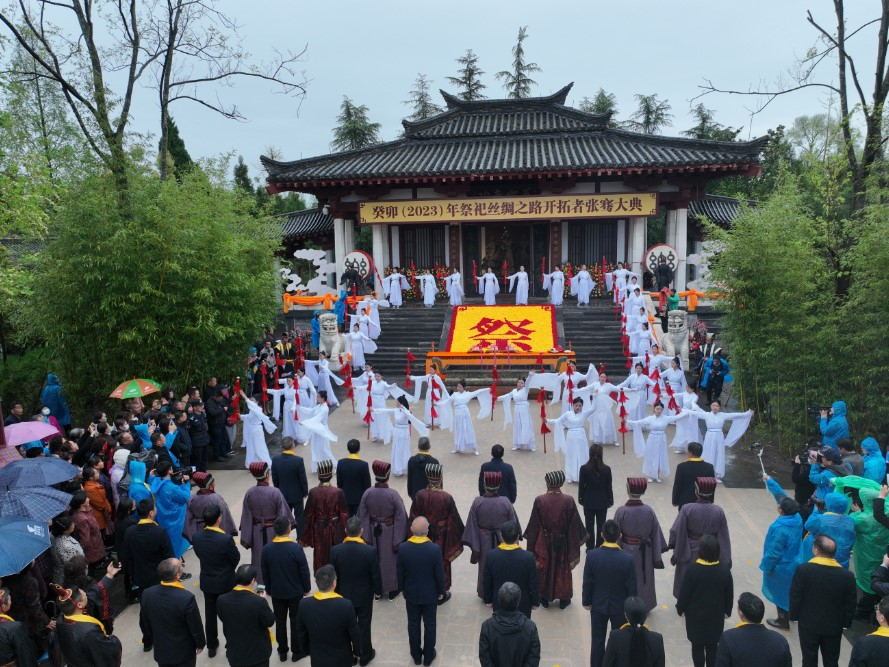County-level museum in Hanzhong thrives because of Three Kingdoms culture

Photo shows bronze caltrops provided by the Mianxian county museum at a Japanese exhibition about the Three Kingdoms in 2019. [Photo from the Mianxian county museum]
The Three Kingdoms period (220-280 AD), a fascinating age in early history featuring the tripartite division of China among the dynastic states of Wei, Shu, and Wu, is one of the most widely known periods of history in China. The culture related to it has a profound impact.
As the main battlefield between Wei and Shu during the Three Kingdoms period, Hanzhong in northwest China's Shaanxi province possesses an important geographic position.
In the Three Kingdoms period, there was a saying that "The one who gets the Dingjun Mountain gets Hanzhong, and the one who gets Hanzhong gets the country."
Then where is the Dingjun Mountain?
It is located in Mianxian county, a small town with a history of over 2,000 years in Hanzhong.
Over the recent years, the Mianxian county museum has made its name thanks to its efforts to enrich its collection, innovate advertizing models, and promote the culture of the Three Kingdoms. It is presenting the beauty of Chinese history and culture to more and more visitors.

Photo shows a pottery "money tree" from the Eastern Han Dynasty (25-220). [Photo from the Mianxian county museum]
The museum is not big in size, but it houses a number of cultural relics and items that are seemingly able to bring visitors back to the volatile Three Kingdoms period, such as bronze caltrops, a bronze crossbow that dates back to nearly 1,800 years ago, and a valuable model of a Chinese quadrangle built in the Eastern Han Dynasty (25-220).
Deputy head of the museum Xiao Yongqin, who has worked for the museum for over 10 years, told People's Daily that these cultural relics are of vital importance for studying the history of the Three Kingdoms period because not many documents and relevant items from that faraway period still remain today.
Many of the cultural relics displayed at the Mianxian county museum have their own stories.
In about the 1970s and 1980s, a type of ancient weapon called "tongjili," or bronze caltrop, was discovered in Wuhouping, which is near the Dingjun Mountain and the Hanjiang River in Mianxian county. The weapon has four spikes, each with a length of 2 centimeters. When it is thrown on the ground, in whatever manner, one of spikes always points upward. This weapon was used in ancient times to slow cavalries and troops and thus nicknamed "horse spike" in China.
According to historical records, Yang Yi, an official of the state of Shu in the Three Kingdoms period, once used bronze caltrops to prevent the pursuers sent by Sima Yi, a military general of the state of Wei.
"This weapon is similar to today's roadblocks," said Qin Jiaying, a guide of the museum.
The museum now boasts a rich collection that consists of over 2,000 cultural relics it unearthed, purchased and collected. Some of these cultural relics have been displayed at the National Museum of China, the Military Museum of the Chinese People's Revolution and the Shaanxi History Museum. They also joined itinerant exhibitions to Japan, the United States, the UK, among others.
Bigger museums have bigger foot traffic, but they don't have many cultural relics from the Three Kingdoms period on display. How the Mianxian county museum can give play to its advantages as a county-level facility that collects a large number of Three Kingdoms cultural relics has been a major focus of Xiao over the recent years.

A ceremony in memory of Zhang Qian is held at the Mianxian county museum, Hanzhong, northwest China's Shaanxi province, April 3, 2023. Zhang Qian is a royal emissary in China's Han Dynasty (202 B.C.-220 A.D.) who traveled westward on a mission of peace and opened an overland route linking the East and the West. [Photo from the Publicity Department of the Communist Party of China Hanzhong Municipal Committee]
He believes what builds the public's affection for culture is enduring access to culture.
Therefore, the Mianxian county museum turned to social media. It has made a short video series about cultural relics, which is released one episode each week, and is publishing an article about history, traditional culture and news of the museum on each workday on WeChat.
The change in publicity models has constantly expanded the influence of the museum. The number of visits to the Mianxian county museum grew at least 30 percent during this year's May Day holiday from four years ago.
There's much remained to be done in the preservation of cultural relics and cultural promotion, said Xiao.
"Only by well telling the stories of cultural relics and making them lively can we attract more people to the culture of the Three Kingdoms and the Chinese history," he added.
The development of the Mianxian county museum is a miniature of Hanzhong utilizing its featured culture and exploring the integrated development of culture and tourism.
Hanzhong has a long history and profound culture. It is home to the Tomb of Zhang Qian, a UNESCO World heritage site, the Hanzhong Sanyan water conservancy project, which is listed in the World Heritage Irrigation Structures, as well as the Longgang Temple Ruins under national-level protection.
Over the recent years, Hanzhong has launched a series of featured cultural activities such as a ceremony in memory of Zhang Qian and a travel festival themed with Zhuge Liang, a strategist who served as the imperial chancellor of the state of Shu in the Three Kingdoms period. It also developed a number of cultural and travel products such as food festivals and immersive performances.
During the May Day holiday this year, the city launched over 130 cultural and tourism activities. Both the number of visitors it received and the tourism revenue during the holiday exceeded those in 2019.
























